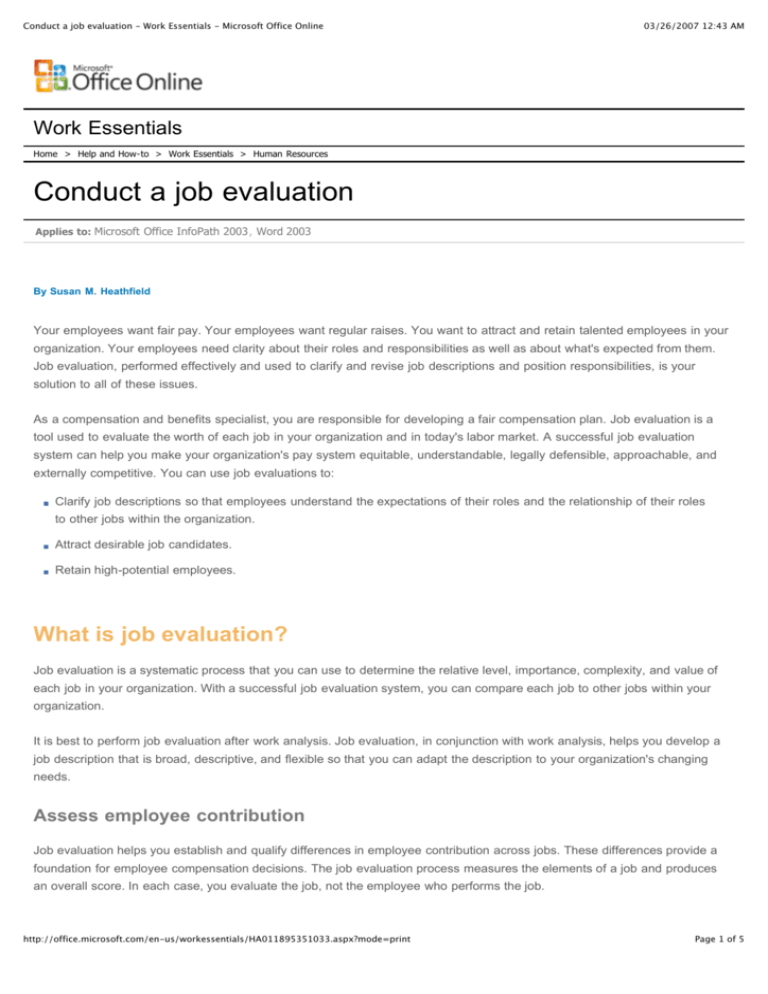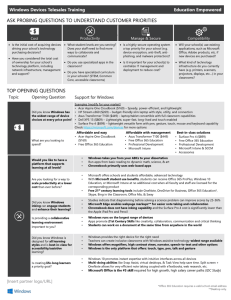
Conduct a job evaluation - Work Essentials - Microsoft Office Online
03/26/2007 12:43 AM
Work Essentials
Home > Help and How-to > Work Essentials > Human Resources
Conduct a job evaluation
Applies to: Microsoft Office InfoPath 2003 , Word 2003
By Susan M. Heathfield
Your employees want fair pay. Your employees want regular raises. You want to attract and retain talented employees in your
organization. Your employees need clarity about their roles and responsibilities as well as about what's expected from them.
Job evaluation, performed effectively and used to clarify and revise job descriptions and position responsibilities, is your
solution to all of these issues.
As a compensation and benefits specialist, you are responsible for developing a fair compensation plan. Job evaluation is a
tool used to evaluate the worth of each job in your organization and in today's labor market. A successful job evaluation
system can help you make your organization's pay system equitable, understandable, legally defensible, approachable, and
externally competitive. You can use job evaluations to:
Clarify job descriptions so that employees understand the expectations of their roles and the relationship of their roles
to other jobs within the organization.
Attract desirable job candidates.
Retain high-potential employees.
What is job evaluation?
Job evaluation is a systematic process that you can use to determine the relative level, importance, complexity, and value of
each job in your organization. With a successful job evaluation system, you can compare each job to other jobs within your
organization.
It is best to perform job evaluation after work analysis. Job evaluation, in conjunction with work analysis, helps you develop a
job description that is broad, descriptive, and flexible so that you can adapt the description to your organization's changing
needs.
Assess employee contribution
Job evaluation helps you establish and qualify differences in employee contribution across jobs. These differences provide a
foundation for employee compensation decisions. The job evaluation process measures the elements of a job and produces
an overall score. In each case, you evaluate the job, not the employee who performs the job.
http://office.microsoft.com/en-us/workessentials/HA011895351033.aspx?mode=print
Page 1 of 5
Conduct a job evaluation - Work Essentials - Microsoft Office Online
03/26/2007 12:43 AM
Assess job content and value
Typically, job evaluation assesses both the content of a job and the value of a job for your organization.
Job content refers to the type of work performed and the skills and knowledge necessary to perform the work.
Job value refers to the job's degree of contribution in meeting your organization's goals and the degree of difficulty in
filling the job.
Factors in job evaluation
Job evaluators often assess jobs based on these factors:
Training level or qualifications requirements
Knowledge and skills requirements
Complexity of tasks
Interaction with various levels of the organization
Problem-solving and independent judgment
Accountability and responsibility
Decision-making authority
Degree of supervision required
Cross-training requirements
Working conditions
Degree of difficulty in filling job
Implement job evaluation
The concept of job evaluation often can be intimidating to employees in an established organization. Employees might worry
about losing their jobs, and pay might be decreased after job comparisons and evaluations are completed. To help employees
accept and understand your job evaluation system, approach job evaluation from an organizational development perspective.
Create a team
To promote widespread support, understanding, and acceptance across your organization, create a cross-functional team to
work on job evaluation. The team should represent various levels and jobs within your organization.
Select the job evaluation method
The team can work together to evaluate and select a job evaluation method. Train team members in the requirements of the
Fair Labor Standards Act and any other best practices for selecting a job evaluation method for your organization.
Communicate with employees
http://office.microsoft.com/en-us/workessentials/HA011895351033.aspx?mode=print
Page 2 of 5
Conduct a job evaluation - Work Essentials - Microsoft Office Online
03/26/2007 12:43 AM
During the implementation of job evaluation, regularly communicate with employees throughout the process. This helps
employees feel a sense of ownership from the results of the job evaluation results.
Steps in job evaluation
The standard steps in job evaluation include:
1. Introduce the concept of job evaluation.
2. Obtain management approval for the evaluation.
3. Train the job evaluation selection team.
4. Review and select the job evaluation method.
5. Gather information on all internal jobs.
6. Use information to fully expand job descriptions.
7. Use the selected job evaluation method to rank jobs hierarchically or in groups.
8. Link the ranked jobs with your compensation system or develop a new system.
9. Implement the job evaluation and compensation systems.
10 . Periodically review your job evaluation system and the resulting compensation decisions.
Analyze job evaluation methods
Before implementing job evaluation in your organization, select the most appropriate job evaluation method. Hundreds of job
evaluation systems exist. Research the job evaluation methods and resources available online. Five job evaluation systems
are most commonly used:
Ranking
Classification
Point evaluation
Factor comparison
Market comparison
Ranking
Ranking jobs is the easiest, fastest, and least expensive approach to job evaluation. It is also most effective in smaller
organizations with few job classifications. To rank positions, order jobs from highest to lowest based on their relative value to
your organization.
The process of job ranking typically assigns more value to jobs that require managerial or technical competencies. More value
is also assigned to jobs that supervise, exercise decision-making authority, or rely on independent judgment. For example, a
job-ranking system might rank the job of CEO as the most valued job within the organization and the job of product assembler
as the least valued.
http://office.microsoft.com/en-us/workessentials/HA011895351033.aspx?mode=print
Page 3 of 5
Conduct a job evaluation - Work Essentials - Microsoft Office Online
03/26/2007 12:43 AM
Advantages Simplicity is the main advantage in using a ranking system. It is also easy to communicate the results to
employees, and it is easy to understand.
Disadvantages Ranking jobs is subjective. Jobs are evaluated, and their value and complexity are often assessed on
the basis of opinion. Also, when creating a new job, existing jobs must be reranked to accommodate the the new
position.
Classification
The general purpose of job classification is to create and maintain pay grades for comparable work across your organization.
To conduct a job classification: First, write descriptions for a category of jobs; next, develop standards for each job category
by describing the key characteristics of those jobs in the category; finally, match all jobs to the categories based on the
similarity of tasks, the decision-making exercised, and the job's contribution to the organization's overall goals.
Universities, government employers and agencies, and other large organizations with limited resources typically use job
classification systems. These types of organizations have many types of jobs at diverse locations and must maintain equitable
and fair standards across all work settings.
Advantage Job classification is simple once you establish your categories. You can assign new jobs and jobs with
changing responsibilities within the existing system.
Disadvantages Job classification is subjective, so jobs mightfall into several categories. Decisions rely on the
judgment of the job evaluator. Job evaluators must evaluate jobs carefully because similar titles might describe
different jobs from different work sites.
Point evaluation
Point evaluation is the most widely used job evaluation method. In a point evaluation system, you express the value of a
particular job in monetary terms. You first identify compensable factors that a group of jobs possess. Based on these factors,
you assign points that numerically represent the description and range of the job.
Examples of compensable factors are skills required, level of decision-making authority, number of reporting staff members,
and working conditions.
Advantage This method is often viewed as less biased than other methods because the job evaluator assigns each
job's total points before the compensable factors become part of the equation.
Disadvantages Subjective decisions about compensable factors and the associated points assigned might be
dominate. The job evaluator must be aware of biases and ensure that they are not represented in points assigned to
jobs that are traditionally held by minority and female employees.
Factor comparison
Job evaluators rank jobs that have similar responsibilities and tasks according to points assigned to compensable factors. The
evaluators then analyze jobs in the external labor market to establish the market rate for such factors. Jobs across the
organization are then compared to the benchmark jobs according to the market rate of each job's compensable factors to
determine job salaries.
http://office.microsoft.com/en-us/workessentials/HA011895351033.aspx?mode=print
Page 4 of 5
Conduct a job evaluation - Work Essentials - Microsoft Office Online
03/26/2007 12:43 AM
Advantage This method results in customized job-ranking.
Disadvantage Compensable factor comparison is a time-consuming and subjective process.
Market comparison
Job evaluators compare compensation for your organization's jobs to the market rate for similar jobs. This method requires
accurate market-pricing surveys.
The value of job evaluation
Job evaluation is a powerful tool in the compensation and benefits specialist's repertoire. Effective job evaluation helps you
gather information to develop job descriptions that meet the changing needs of your organization. By implementing a
successful job evaluation, you can develop an equitable compensation plan and attract and retain high-performing and
talented employees.
More information
Conduct an effective pay study
Use market pay data to develop appropriate pay scales
Develop a pay structure that reflects your company values
About the author Susan M. Heathfield is a management and organization development consultant who helps organizations
strategically value and utilize people. Her company promotes business success and profitability through consultation, executive
and management coaching, organization development strategies, human resources system and policy development, team
building, customized training, and writing.
Original page: http://office.microsoft.com/en-us/workessentials/HA011895351033.aspx
© 2007 Microsoft Corporation. All rights reserved.
http://office.microsoft.com/en-us/workessentials/HA011895351033.aspx?mode=print
Page 5 of 5








